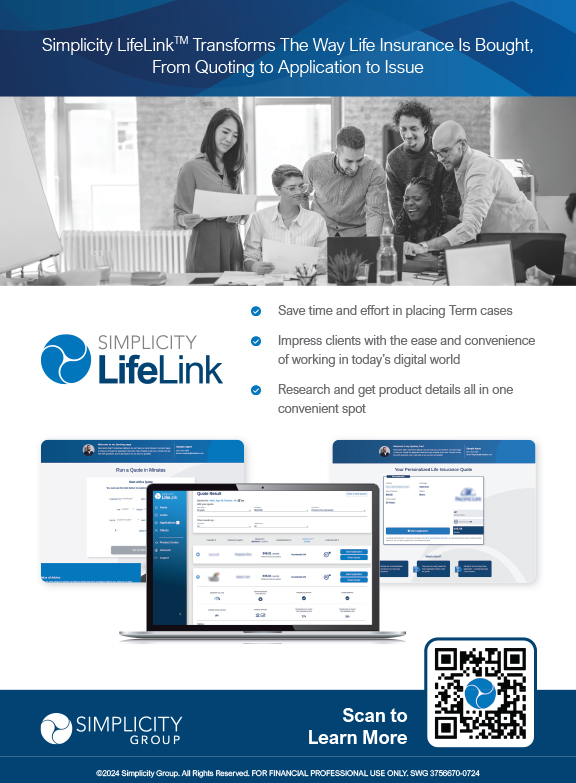What’s old is new again. In the mid-1980s when you were taking an individual health application, if a client would say—”Just a minute, I need to check my blood sugar”—you knew automatically that your next question would be, “Where do you work?” At that time it was possible to acquire small group comprehensive health insurance with only three lives, either guaranteed issue or modified guaranteed issue.
In April 2004—when I began writing for BROKER WORLD—one of my early columns, “The Visit,” proposed more aggressive small group marketing. In that same year I created the first packaged multi-life product with Loyal American Life. Multi-life is a list bill of individual LTC insurance products; it looks like small group insurance and it is marketed and sold accordingly. To reiterate what has been mentioned in my columns on numerous occasions: This is a massive sales opportunity.
There are several million American businesses with fewer than 500 lives. After all these years, something less than 20,000 business owners both own or offer LTC insurance. Even Washington can understand that math.
LIMRA surveys have identified LTC insurance as the most popular worksite benefit. I can also confirm that the majority of small group sales bubbled up at the worksite. Although the sales are improving, most did not originate with the agent asking the right questions. Instead, workers or owners recognized financial self-interest or experienced caregiving realities for family members, which created the momentum for sales. Pricing for individual LTC insurance is built on an expectation that known potential claims will be turned at the door. Depending on age, one out of every three or four applications is declined at the home office. This number does not reflect those turned down by good field underwriting practices.
Multi-life is different. By definition we are spreading the risk. There is still a full battery of gatekeeper exclusions. We are substantially protected by an actively at work status and, therefore, can afford some blended morbidity assumptions. Reduced underwriting also means reduced administrative expense.
Benefits are available on a reduced basis and, for the most part, standard not preferred ratings are utilized providing additional risk mitigation. You can currently count on two hands the companies providing reduced underwriting concessions for small groups. Many of these new opportunities have only recently joined the market.
Frankly the multi-life, true group and association business has been keeping LTC insurance alive. According to Jennifer Douglas, associate research director, LIMRA, “In 2009, nearly half of all new buyers (48 percent) purchased LTC insurance through or at work (whether true group or individual worksite), accounting for 27 percent of all new premium. Those percentages are 54 and 35 if you include association business (the majority of that was individual multi-life).” In other words, affinity-based sales represents the great and vast majority of new sales.
These small group products are built in a similar manner. There are usually two thresholds for underwriting concessions. One threshold is based on an employer contribution and one on a purely voluntary basis.
There is a lot of confusion about how companies refer to their modified guarantee issue option. In my opinion there are only three categories of LTC insurance group underwriting.
Guarantee issue is guarantee issue. Although over the years I remember vividly asking underwriters, “What part of guarantee issue did you not understand?”
Modified guarantee issue means that the underwriting will take place exclusively off the short form application. If you answer the questions correctly, you will get a policy. This means absolute predictability of the underwriting outcome.
Simplified issue, on the other hand, means that although the process and application may be abbreviated, the company reserves the right to perform additional underwriting, including: prescription drug screens, APSs and phone interviews.
Regardless of what a company names an underwriting option, I just want to know how it actually works. I am often working with clients who have already experienced rejection or disappointment with LTC insurance underwriting and I do not want to be responsible for revisiting that experience.
Multi-life operates successfully in a classic wholesale brokerage environment. No one company has a monopoly on the truth. There are substantial differences in affinity discounts, marital discounts, specific underwriting questions, employer contribution requirements, benefit availability, commission haircuts, policy form availability, technology (online applications) and premium.
My own placement ratio has improved substantially over the last six years. Currently the majority of cases we initiate conclude in placing some level of protection.
Here is what I have learned:
1. Take your time and identify the buying motivation before you begin to sell. What brought your client to the party?
2. Each sale is about explaining and illuminating a known risk and then looking for the commitment to solve the problem. You are always drawing a line in the census.
3. LTC insurance buyers are only those who plan ahead or care ahead. The sale is always about protecting money or preventing caregiving burdens.
4. Educate your prospect first and show premium last.
5. Each sale is a normal progression from executive carve-out to core buy up to voluntary. Employer commitment and participation in the solution is pivotal.
6. Step back from your ego. If you must do voluntary, ask for professional help to provide an aggressive educational campaign and professional enrollment assistance. Successful voluntary sales can be brutal and elusive.
7. Understand the important pressure points in the sales process and seek assistance from a knowledgeable LTC insurance brokerage operation that will provide sales support and not just proposals.
8. A Section 105 medical reimbursement plan allows you to create classes of benefit availability based on length of service, occupation and income. Any employee census can be “sliced and diced” to meet your needs.
9. Never forget your basic mantra: deductible premiums (all or part), tax-free benefits, no FICA, no FUTA and no W-2s.
10. LTC insurance is the best bang for the buck in the benefit market. It can be very inexpensive and usually represents less than 1 percent of payroll and is a fixed budget item which diminishes over time.
Modified guarantee issue is available at three lives. Participants are not required to have homogenous benefits. Almost everyone actively at work may be able to get coverage even if previously declined.
Get a census on Excel (not on a napkin), with date of birth, marital status and job description with income. Contact an LTC insurance BGA with multi-life expertise and help many more protect themselves and their families.
Other than that, I have no real opinion on the subject.
























